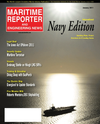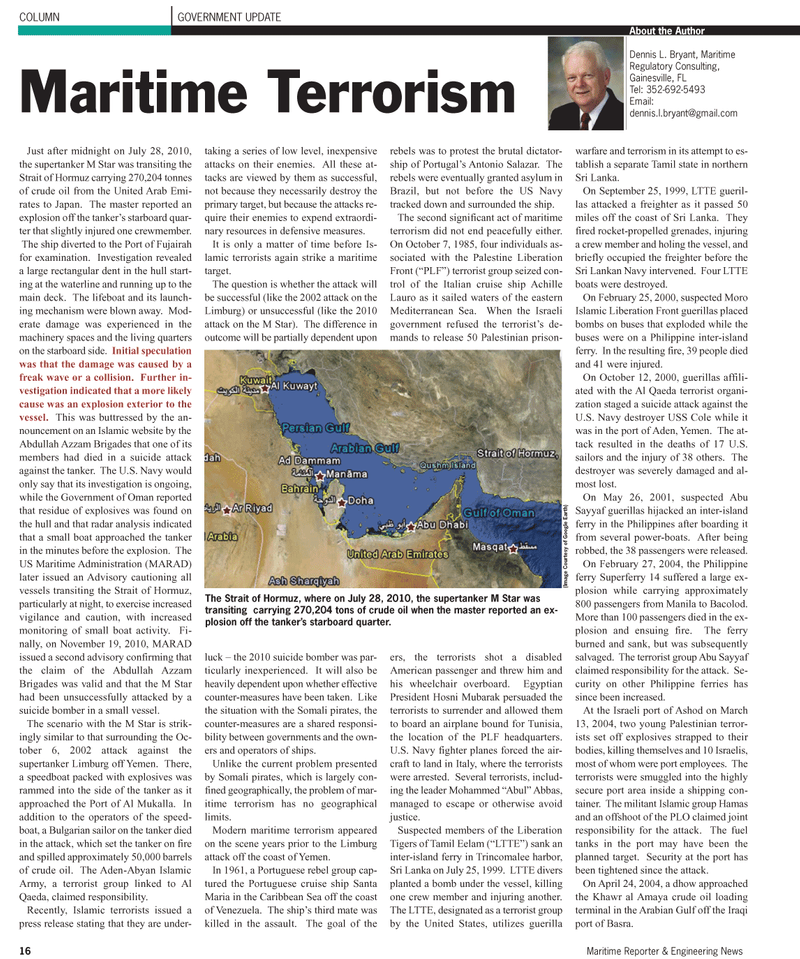
Page 16: of Maritime Reporter Magazine (January 2011)
International Naval Technology
Read this page in Pdf, Flash or Html5 edition of January 2011 Maritime Reporter Magazine
16 Maritime Reporter & Engineering News
COLUMN GOVERNMENT UPDATE
Just after midnight on July 28, 2010, the supertanker M Star was transiting the
Strait of Hormuz carrying 270,204 tonnes of crude oil from the United Arab Emi- rates to Japan. The master reported an explosion off the tanker’s starboard quar- ter that slightly injured one crewmember.
The ship diverted to the Port of Fujairah for examination. Investigation revealed a large rectangular dent in the hull start- ing at the waterline and running up to the main deck. The lifeboat and its launch- ing mechanism were blown away. Mod- erate damage was experienced in the machinery spaces and the living quarters on the starboard side. Initial speculation was that the damage was caused by a freak wave or a collision. Further in- vestigation indicated that a more likely cause was an explosion exterior to the vessel. This was buttressed by the an- nouncement on an Islamic website by the
Abdullah Azzam Brigades that one of its members had died in a suicide attack against the tanker. The U.S. Navy would only say that its investigation is ongoing, while the Government of Oman reported that residue of explosives was found on the hull and that radar analysis indicated that a small boat approached the tanker in the minutes before the explosion. The
US Maritime Administration (MARAD) later issued an Advisory cautioning all vessels transiting the Strait of Hormuz, particularly at night, to exercise increased vigilance and caution, with increased monitoring of small boat activity. Fi- nally, on November 19, 2010, MARAD issued a second advisory confirming that the claim of the Abdullah Azzam
Brigades was valid and that the M Star had been unsuccessfully attacked by a suicide bomber in a small vessel.
The scenario with the M Star is strik- ingly similar to that surrounding the Oc- tober 6, 2002 attack against the supertanker Limburg off Yemen. There, a speedboat packed with explosives was rammed into the side of the tanker as it approached the Port of Al Mukalla. In addition to the operators of the speed- boat, a Bulgarian sailor on the tanker died in the attack, which set the tanker on fire and spilled approximately 50,000 barrels of crude oil. The Aden-Abyan Islamic
Army, a terrorist group linked to Al
Qaeda, claimed responsibility.
Recently, Islamic terrorists issued a press release stating that they are under- taking a series of low level, inexpensive attacks on their enemies. All these at- tacks are viewed by them as successful, not because they necessarily destroy the primary target, but because the attacks re- quire their enemies to expend extraordi- nary resources in defensive measures.
It is only a matter of time before Is- lamic terrorists again strike a maritime target.
The question is whether the attack will be successful (like the 2002 attack on the
Limburg) or unsuccessful (like the 2010 attack on the M Star). The difference in outcome will be partially dependent upon luck – the 2010 suicide bomber was par- ticularly inexperienced. It will also be heavily dependent upon whether effective counter-measures have been taken. Like the situation with the Somali pirates, the counter-measures are a shared responsi- bility between governments and the own- ers and operators of ships.
Unlike the current problem presented by Somali pirates, which is largely con- fined geographically, the problem of mar- itime terrorism has no geographical limits.
Modern maritime terrorism appeared on the scene years prior to the Limburg attack off the coast of Yemen.
In 1961, a Portuguese rebel group cap- tured the Portuguese cruise ship Santa
Maria in the Caribbean Sea off the coast of Venezuela. The ship’s third mate was killed in the assault. The goal of the rebels was to protest the brutal dictator- ship of Portugal’s Antonio Salazar. The rebels were eventually granted asylum in
Brazil, but not before the US Navy tracked down and surrounded the ship.
The second significant act of maritime terrorism did not end peacefully either.
On October 7, 1985, four individuals as- sociated with the Palestine Liberation
Front (“PLF”) terrorist group seized con- trol of the Italian cruise ship Achille
Lauro as it sailed waters of the eastern
Mediterranean Sea. When the Israeli government refused the terrorist’s de- mands to release 50 Palestinian prison- ers, the terrorists shot a disabled
American passenger and threw him and his wheelchair overboard. Egyptian
President Hosni Mubarak persuaded the terrorists to surrender and allowed them to board an airplane bound for Tunisia, the location of the PLF headquarters.
U.S. Navy fighter planes forced the air- craft to land in Italy, where the terrorists were arrested. Several terrorists, includ- ing the leader Mohammed “Abul” Abbas, managed to escape or otherwise avoid justice.
Suspected members of the Liberation
Tigers of Tamil Eelam (“LTTE”) sank an inter-island ferry in Trincomalee harbor,
Sri Lanka on July 25, 1999. LTTE divers planted a bomb under the vessel, killing one crew member and injuring another.
The LTTE, designated as a terrorist group by the United States, utilizes guerilla warfare and terrorism in its attempt to es- tablish a separate Tamil state in northern
Sri Lanka.
On September 25, 1999, LTTE gueril- las attacked a freighter as it passed 50 miles off the coast of Sri Lanka. They fired rocket-propelled grenades, injuring a crew member and holing the vessel, and briefly occupied the freighter before the
Sri Lankan Navy intervened. Four LTTE boats were destroyed.
On February 25, 2000, suspected Moro
Islamic Liberation Front guerillas placed bombs on buses that exploded while the buses were on a Philippine inter-island ferry. In the resulting fire, 39 people died and 41 were injured.
On October 12, 2000, guerillas affili- ated with the Al Qaeda terrorist organi- zation staged a suicide attack against the
U.S. Navy destroyer USS Cole while it was in the port of Aden, Yemen. The at- tack resulted in the deaths of 17 U.S. sailors and the injury of 38 others. The destroyer was severely damaged and al- most lost.
On May 26, 2001, suspected Abu
Sayyaf guerillas hijacked an inter-island ferry in the Philippines after boarding it from several power-boats. After being robbed, the 38 passengers were released.
On February 27, 2004, the Philippine ferry Superferry 14 suffered a large ex- plosion while carrying approximately 800 passengers from Manila to Bacolod.
More than 100 passengers died in the ex- plosion and ensuing fire. The ferry burned and sank, but was subsequently salvaged. The terrorist group Abu Sayyaf claimed responsibility for the attack. Se- curity on other Philippine ferries has since been increased.
At the Israeli port of Ashod on March 13, 2004, two young Palestinian terror- ists set off explosives strapped to their bodies, killing themselves and 10 Israelis, most of whom were port employees. The terrorists were smuggled into the highly secure port area inside a shipping con- tainer. The militant Islamic group Hamas and an offshoot of the PLO claimed joint responsibility for the attack. The fuel tanks in the port may have been the planned target. Security at the port has been tightened since the attack.
On April 24, 2004, a dhow approached the Khawr al Amaya crude oil loading terminal in the Arabian Gulf off the Iraqi port of Basra.
Maritime Terrorism
About the Author
Dennis L. Bryant, Maritime
Regulatory Consulting,
Gainesville, FL
Tel: 352-692-5493
Email: [email protected] (Image Cour tesy of Google Ear th)
The Strait of Hormuz, where on July 28, 2010, the supertanker M Star was transiting carrying 270,204 tons of crude oil when the master reported an ex- plosion off the tanker’s starboard quarter.

 15
15

 17
17
